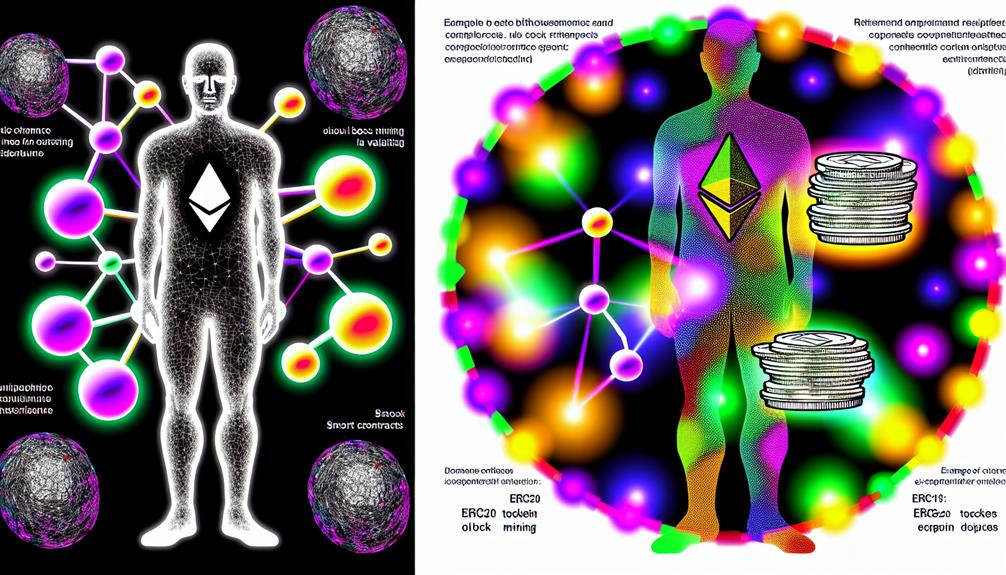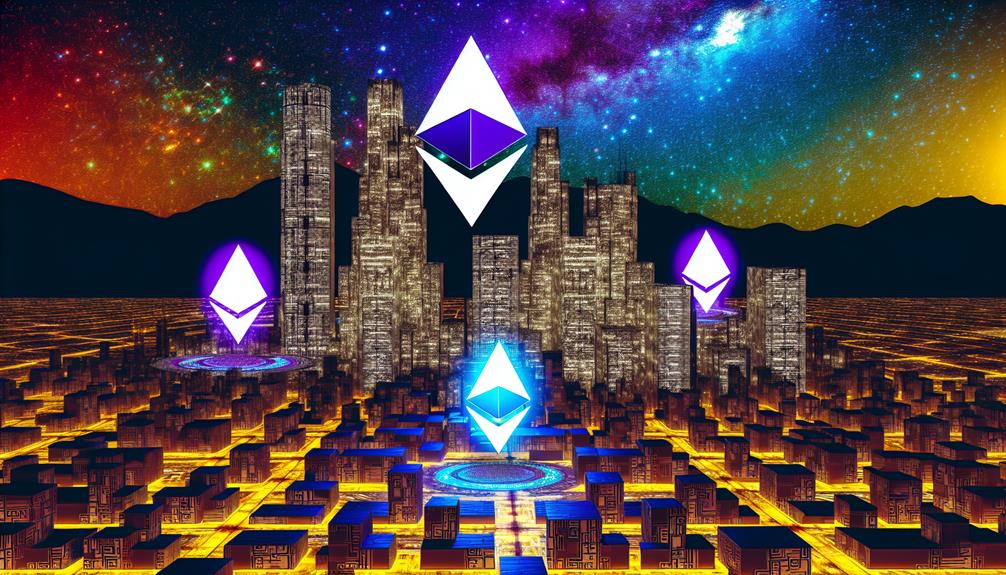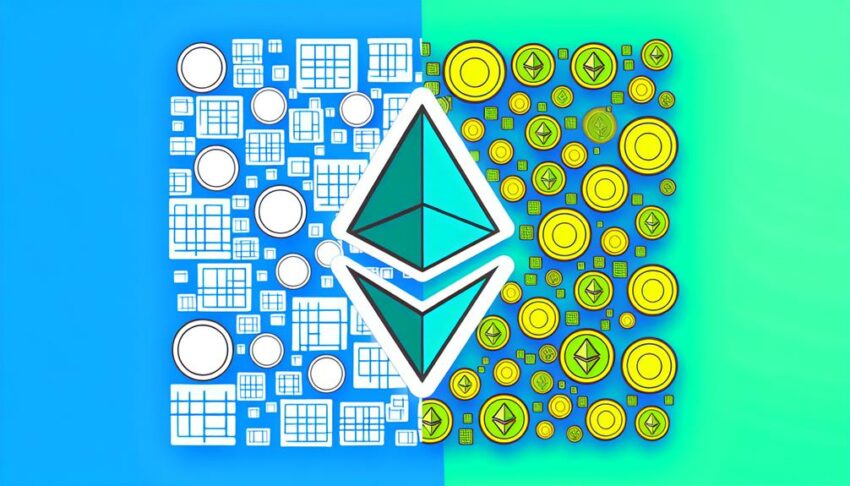Imagine a bustling city where the roads represent Ethereum, allowing all kinds of vehicles to travel freely, while the specific buses that follow designated routes symbolize ERC20 tokens. You might wonder if these buses are the same as the city itself. The distinction between Ethereum and ERC20 isn't just a matter of terminology; it's about understanding their unique roles within the blockchain ecosystem. So, what does that mean for the future of cryptocurrencies and the applications built on Ethereum?
Overview of Ethereum
Ethereum, launched in 2015, is a decentralized platform that enables developers to build and deploy smart contracts and decentralized applications (dApps). At its core, Ethereum architecture consists of several key components, including the Ethereum Virtual Machine (EVM), which executes smart contracts and maintains system integrity. As you explore Ethereum, you'll notice that scalability remains a significant concern, as the network must handle an increasing number of transactions without compromising speed or efficiency.
Ethereum consensus mechanisms, primarily based on proof-of-stake (PoS) since the Ethereum 2.0 upgrade, guarantee that transactions are validated securely and efficiently. This shift enhances both Ethereum security and scalability, addressing earlier limitations posed by proof-of-work mining. The Ethereum community plays a critical role in guiding these upgrades, continuously improving the platform's capabilities and addressing user concerns through decentralized governance.
When you interact with Ethereum applications, you'll find a wide range of use cases, from finance (DeFi) to digital art (NFTs). Users often utilize Ethereum wallets to manage their assets, making sure that transactions are secure and seamless. While Ethereum mining was once a popular method for transaction validation, the change to PoS has shifted this paradigm, making it more energy-efficient.
Understanding ERC20 Tokens
ERC20 tokens are an essential part of the Ethereum ecosystem, serving as digital assets that adhere to specific standards. Understanding their definition, functionality, and popular examples can provide you with insights into how they operate and their significance in the blockchain space. By grasping these concepts, you'll appreciate the role ERC20 tokens play in decentralized applications and the broader cryptocurrency market.
Definition of ERC20 Tokens
In the world of blockchain technology, ERC20 tokens represent a pivotal innovation that enhances the functionality of the Ethereum network. Basically, ERC20 is a technical standard used for smart contracts on the Ethereum blockchain, defining how tokens can be created, exchanged, and interacted with. You'll find that these tokens possess unique ERC20 characteristics that make them easily recognizable and usable within the Ethereum ecosystem.
One of the primary benefits of ERC20 tokens is their token interoperability. This means that different ERC20 tokens can work seamlessly with each other, allowing for greater flexibility and usability across various applications and platforms. When you engage with an ERC20 token, whether it's for trading or using it in a decentralized application, you can expect a consistent user experience due to these standardized features.
Additionally, the adoption of ERC20 has spurred a myriad of projects, creating a robust environment for digital assets. By understanding the definition of ERC20 tokens, you can better appreciate how they contribute to the broader landscape of cryptocurrency and blockchain technology, fostering innovation and collaboration.
Functionality and Standards
Understanding the functionality and standards of ERC20 tokens is essential to grasping their role within the Ethereum ecosystem. ERC20 outlines a set of rules and standards that these tokens must follow, ensuring they can interact seamlessly with one another and with decentralized applications (dApps). This concept of token interoperability is vital; it allows developers to integrate various tokens into their projects without having to reinvent the wheel each time.
The ERC20 standard defines specific functions, such as transferring tokens and querying balances, which means you can easily manage assets on the Ethereum blockchain. This standardization not only simplifies development but also enhances blockchain scalability. When tokens adhere to the ERC20 standard, they can be easily listed on exchanges, utilized in smart contracts, or integrated into wallets, thereby expanding their usability across the ecosystem.
Moreover, the standard promotes a level of reliability and trust, enabling users to engage with multiple tokens confidently. As you explore ERC20 tokens, keep in mind that their functionality and adherence to these standards considerably contribute to the overall efficiency and dynamism of the Ethereum platform.
Popular ERC20 Examples
Across the Ethereum landscape, various ERC20 tokens have emerged, each offering unique functionalities and purposes. You've likely heard of some popular tokens that have gained significant traction in the crypto community. For instance, Tether (USDT) is a stablecoin pegged to the US dollar, providing a stable medium of exchange amidst the volatility of cryptocurrencies. Then there's Chainlink (LINK), which plays an essential role in connecting smart contracts with real-world data, enhancing their functionality.
Another significant example is Uniswap (UNI), a governance token for the decentralized exchange Uniswap, allowing users to influence platform decisions. These token examples showcase the versatility of ERC20 tokens in different sectors, from finance to data or governance.
Additionally, DAI, a decentralized stablecoin, offers an alternative to traditional fiat-backed tokens by maintaining its value through smart contracts and collateralization. By understanding these popular tokens, you get a clearer picture of how ERC20 standards enable diverse projects to thrive on the Ethereum network. As you explore deeper into the world of cryptocurrencies, recognizing these tokens can help you make informed decisions and appreciate the innovation unfolding within this ecosystem.
Key Differences Between Ethereum and ERC20

Ethereum and ERC20 often get mentioned in the same breath, but they serve distinct purposes within the blockchain ecosystem. To understand the differences, you need to first recognize that Ethereum is a blockchain platform, while ERC20 is a technical standard for creating tokens on that platform. This Ethereum comparison highlights a fundamental distinction: Ethereum provides the infrastructure, whereas ERC20 defines how tokens can be created and managed.
One key difference lies in their functionality. Ethereum allows developers to build decentralized applications (dApps) and smart contracts, enabling a wide range of use cases beyond just currency. On the other hand, ERC20 standardizes the way tokens communicate with one another and with the Ethereum blockchain, facilitating token functionality like transfers, approvals, and balance inquiries. This means that while Ethereum enables diverse applications, ERC20 is specifically focused on the creation and management of tokens within that ecosystem.
Additionally, Ethereum's native currency, Ether (ETH), is used to pay for transaction fees and computational services on the network. In contrast, ERC20 tokens can represent various assets, from utility tokens to stablecoins, and they may serve different purposes depending on their design. So, understanding this distinction is essential if you want to navigate the blockchain landscape effectively. By grasping these key differences, you can better appreciate how Ethereum and ERC20 contribute to the broader digital economy.
The Role of Smart Contracts
Smart contracts play a vital role in the Ethereum ecosystem, acting as self-executing agreements with the terms of the contract directly written into code. This innovative approach allows for smart contract functionality that automates various processes, eliminating the need for intermediaries and reducing the risk of human error. When you interact with a smart contract, you're fundamentally engaging with a digital agreement that executes automatically once pre-defined conditions are met.
One of the most significant advantages of using smart contracts lies in contract automation. You don't have to worry about enforcement or compliance; the code takes care of these tasks. For example, if you're using a decentralized application (dApp) built on Ethereum, smart contracts can automatically handle transactions, ensuring that funds are transferred only when specific criteria are fulfilled. This level of automation streamlines operations and fosters trust among parties involved, as the rules are transparent and immutable.
Moreover, smart contracts enhance security. Once deployed on the Ethereum blockchain, they become tamper-proof, meaning that malicious actors can't alter the terms or outcomes. This security aspect is vital for industries relying on complex agreements, such as finance or supply chain management.
Use Cases for ERC20 Tokens

When you consider ERC20 tokens, it's vital to understand their diverse use cases that extend beyond mere currency. These tokens play a significant role in decentralized finance applications and are often used in initial coin offerings, making them integral to the blockchain ecosystem. By examining token standards, you'll see how they facilitate innovation and functionality within this digital landscape.
Token Standards Explained
Token standards like ERC20 play an essential role in the Ethereum ecosystem, providing a framework that facilitates the creation and management of tokens. By adhering to these standards, developers guarantee token interoperability, allowing different tokens to interact seamlessly within the same environment. This fosters ecosystem growth, enabling diverse applications and use cases.
Here are four significant use cases for ERC20 tokens:
- Initial Coin Offerings (ICOs): ERC20 tokens are often used to raise funds for new projects, providing a way for investors to purchase tokens in exchange for Ethereum or other cryptocurrencies.
- Decentralized Applications (dApps): Many dApps utilize ERC20 tokens for transactions, rewards, or governance, enhancing user engagement and functionality.
- Stablecoins: ERC20 tokens are frequently leveraged to create stablecoins, which are pegged to fiat currencies, allowing users to mitigate volatility in the crypto market.
- Rewards and Loyalty Programs: Businesses can issue ERC20 tokens as part of loyalty programs, incentivizing customers through token rewards that can be used for discounts or special offers.
Understanding these uses highlights the versatility and importance of ERC20 tokens in the broader Ethereum landscape.
Decentralized Finance Applications
Decentralized finance (DeFi) has revolutionized the financial landscape by utilizing ERC20 tokens in innovative ways. These applications leverage the flexibility of ERC20 to create a range of services that traditional finance simply can't offer. You might come across decentralized exchanges that enable peer-to-peer trading without intermediaries, enhancing user incentives through reduced fees.
Consider the following table that highlights key DeFi applications using ERC20 tokens:
| Use Case | Description |
|---|---|
| Yield Farming | Users earn rewards by lending or staking tokens. |
| Liquidity Pools | Pools of tokens provide liquidity for trades. |
| Governance Tokens | Holders vote on protocol changes, enhancing governance. |
| Asset Tokenization | Real-world assets are digitized for easy trading. |
| Financial Derivatives | Complex financial instruments are created on-chain. |
With protocol interoperability and cross-chain compatibility becoming more common, the potential for ERC20 tokens in DeFi is immense. You can also explore staking rewards, where users lock tokens to earn passive income. These innovations not only democratize finance but also pave the way for a more inclusive financial ecosystem.
Initial Coin Offerings
Initial Coin Offerings (ICOs) have become a popular fundraising method for projects utilizing ERC20 tokens, offering startups a way to secure capital by issuing tokens to investors in exchange for cryptocurrency. These fundraising models not only democratize investment opportunities but also reflect current market trends and investor sentiment. However, traversing the landscape involves several important considerations.
- ICO Strategies: Successful projects often employ unique strategies that address their specific market needs.
- Token Regulations: Legal considerations are vital, as regulatory frameworks vary widely across jurisdictions, impacting project viability.
- Community Engagement: Building a supportive community is essential for fostering trust and interest among potential investors.
- Market Trends: Understanding prevailing market trends can help in tailoring a project's approach to meet investor expectations.
Advantages of Using ERC20
When you consider the landscape of blockchain technology, the ERC20 standard stands out for several compelling reasons. One of the primary ERC20 benefits is its ability to foster token interoperability. This means that tokens built on the ERC20 standard can easily interact with various decentralized applications (dApps) and exchanges within the Ethereum ecosystem. You'll find that this interoperability greatly enhances liquidity and accessibility, making it easier for users to trade and utilize diverse tokens.
Another advantage of using ERC20 is the established framework it provides for developers. Since ERC20 sets a clear set of rules and guidelines, it reduces complexity and accelerates the development process. This means that you can launch your token quickly without reinventing the wheel, which is especially beneficial in fast-paced markets where time is of the essence.
Moreover, the robust community and support surrounding ERC20 tokens can't be overlooked. With a large number of developers and projects utilizing this standard, you're more likely to find resources, tools, and partnerships that can help your project succeed. This collaborative environment fosters innovation and accelerates growth.
Lastly, the ERC20 standard has been widely adopted, which means that many wallets, exchanges, and platforms are compatible with ERC20 tokens. This widespread acceptance not only simplifies the user experience but also contributes to the overall credibility and trust in your token. These advantages make ERC20 an attractive choice for anyone looking to create and utilize tokens in the blockchain space.
The Future of Ethereum and ERC20

As the blockchain landscape continues to evolve, the future of Ethereum and the ERC20 standard looks promising. With rising Ethereum scalability, we can expect considerable advancements in user adoption and ecosystem growth. As developers innovate, they'll focus on enhancing ERC20 interoperability, making it even easier for tokens to interact across various platforms.
Here are four key factors shaping the future of Ethereum and ERC20:
- Technological Advancements: Innovations like Ethereum 2.0 aim to improve transaction speed and reduce costs, attracting more users and projects to the ecosystem.
- Market Trends: The increasing investor interest in decentralized finance (DeFi) and non-fungible tokens (NFTs) will drive demand for ERC20 tokens, enhancing their market presence.
- Regulatory Challenges: As governments worldwide develop regulations around cryptocurrencies, how they treat ERC20 tokens will considerably impact user adoption and the overall market environment.
- Blockchain Integration: The ability to integrate with various blockchains will be essential for ERC20 tokens, allowing for seamless transactions and cross-chain functionalities that can enhance their utility.
Frequently Asked Questions
Can ERC20 Tokens Exist on Blockchains Other Than Ethereum?
Yes, ERC20 tokens can exist on blockchains other than Ethereum, thanks to token interoperability and blockchain compatibility. Cross-chain functionality enables developers to implement ERC20 standards across various platforms, expanding their usability beyond Ethereum's network.
How Are ERC20 Tokens Created and Issued?
ERC20 tokens are created through smart contracts by defining specific token standards. You'll need to code functions for transferring, approving, and tracking balances, ensuring compatibility with Ethereum wallets and decentralized applications for seamless usage.
What Wallets Support ERC20 Tokens?
Oh sure, as if every wallet's got a magic touch! For ERC20 tokens, you'll want wallets like MetaMask or MyEtherWallet that boast wallet compatibility and token storage. Don't get stuck with a clunky option!
Are All ERC20 Tokens Interchangeable With Each Other?
While ERC20 tokens follow the same token standards, they aren't always interchangeable due to interoperability issues. Factors like specific functionalities and market conditions can affect their usability and value across different platforms and wallets.
How Do ERC20 Tokens Affect Ethereum's Scalability?
You'd think ERC20 tokens are superheroes, but their reliance on Ethereum's network can slow transaction speeds. As token standards proliferate, they can overwhelm the system, impacting scalability and overall performance. Balancing growth is essential.
Conclusion
To sum up, while you might think ERC20 and Ethereum are the same, they serve distinct purposes within the blockchain ecosystem. Ethereum provides the foundation, enabling smart contracts and dApps, while ERC20 tokens offer a standardized way to create and manage assets on this platform. Some may argue that tokens are just digital assets, but their real value lies in their ability to enhance functionality and foster innovation within the Ethereum network, driving its evolution forward.
